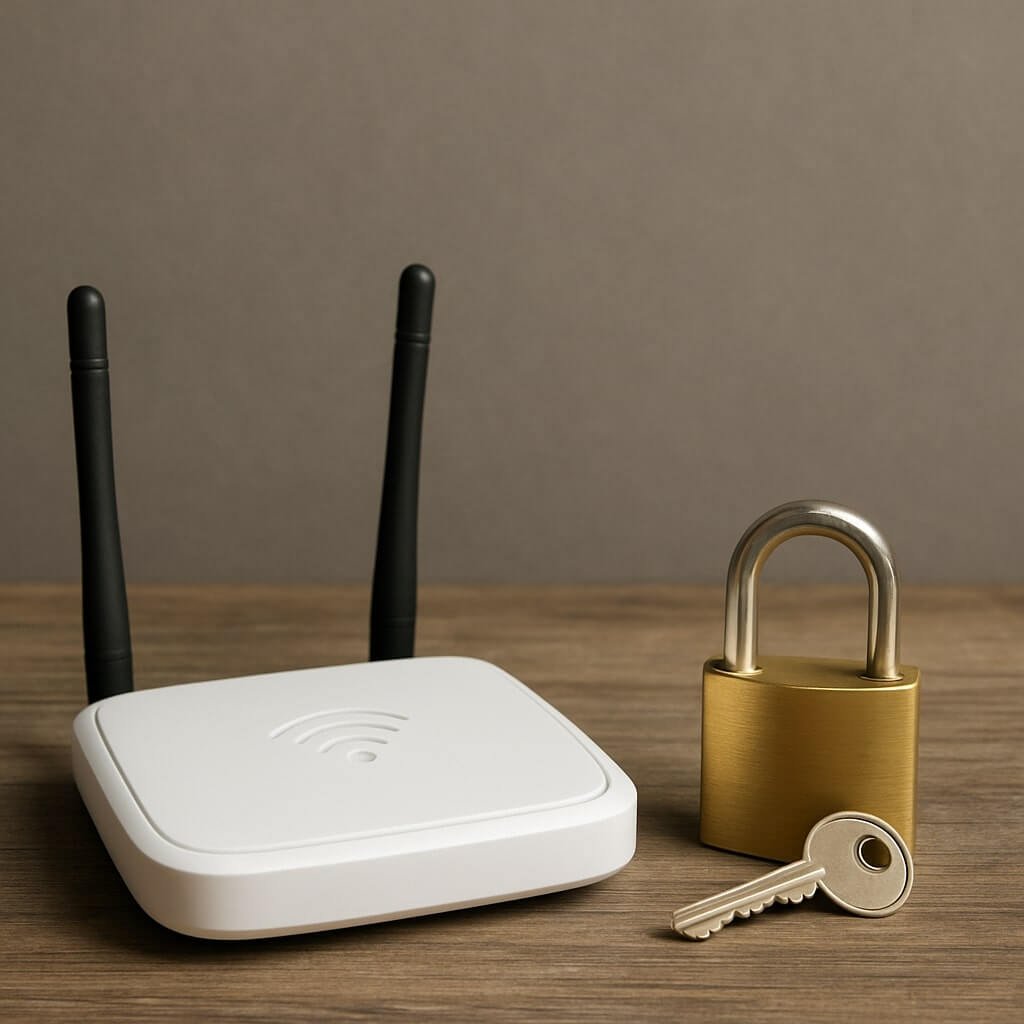Understanding network security keys is essential for maintaining the integrity of your wireless network. By selecting robust keys and utilizing advanced encryption methods, you can greatly reduce the risk of unauthorized access. Yet, many users overlook the importance of key management and regular updates. This guide will detail the steps necessary to secure your network effectively, ensuring you’re equipped to tackle potential vulnerabilities head-on. Are you ready to strengthen your network security?
Key Takeaways
- A network security key acts as a password to protect your wireless network from unauthorized access and data breaches.
- Choose strong keys of 12-16 characters, combining uppercase, lowercase, numbers, and symbols for better security.
- Regularly update your network security key and avoid predictable patterns to enhance protection against potential threats.
- Access your router’s web interface to set or update the security key, ensuring all connected devices use the new key afterward.
- Troubleshoot key issues by verifying the correct key, checking encryption compatibility, and keeping router firmware updated to secure your network.
What Are Network Security Keys?
A network security key serves as a critical component in safeguarding your wireless network. It’s fundamentally a password that controls access to your network, ensuring that only authorized devices can connect.
Without this key, your network remains vulnerable to unauthorized users and potential data breaches.
Network security hinges on the strength and complexity of this key. Different encryption methods, such as WPA2 and WPA3, enhance security by encrypting the data transmitted over your network.
These methods use advanced algorithms that make it difficult for attackers to intercept or decipher your information.
Types of Network Security Keys
Understanding the different types of network security keys is essential for maintaining a secure wireless environment. The most common wireless encryption types include WEP, WPA, and WPA2. Each employs distinct security protocols that impact your network’s vulnerability to attacks.
Here’s a quick security protocols comparison:
| Encryption Type | Security Level |
|---|---|
| WEP | Low – easily cracked |
| WPA | Medium – improved security |
| WPA2 | High – robust encryption |
Choosing the right network security key depends on your specific needs and the devices connected to your network. By understanding these types, you can better protect your data and guarantee a secure connection.
How to Generate a Strong Network Security Key
To generate a strong network security key, you must prioritize complexity and length.
A key should ideally be at least 12 to 16 characters long, incorporating a mix of uppercase letters, lowercase letters, numbers, and special symbols.
This combination considerably enhances security, making it more resilient against unauthorized access.
Importance of Complexity
While many users may underestimate the importance of a strong network security key, its complexity plays a crucial role in safeguarding your data from unauthorized access. A simplistic key can lead to security key vulnerabilities, making it easier for attackers to exploit weaknesses through methods like password cracking.
A complex key, incorporating a mix of uppercase letters, lowercase letters, numbers, and special characters, greatly increases the number of possible combinations, thereby enhancing security. By opting for complexity, you’re not just complicating the access process for yourself but also fortifying your network against potential breaches.
Recommended Length and Characters
A strong network security key typically consists of at least 12 to 16 characters, incorporating a mix of uppercase letters, lowercase letters, numbers, and special characters.
This key length considerably enhances network security by making it more resistant to brute-force attacks. When generating your key, avoid predictable patterns, such as birthdays or common words, which can be easily guessed.
Instead, consider using a passphrase that combines unrelated words or a password manager to create and store a complex key securely.
Regularly updating your network security key is also advisable to mitigate potential vulnerabilities.
Setting up a Wi-Fi Network With Security Keys
When setting up a Wi-Fi network, you must first choose the appropriate type of security key that aligns with your security needs.
Next, configuring your router settings accurately is essential to implementing this key effectively.
These steps are critical to ensuring a secure and reliable wireless connection.
Choosing Security Key Type
Choosing the right type of security key is essential for establishing a secure Wi-Fi network, as it directly impacts both the integrity and confidentiality of your data. A robust security key guarantees effective wireless encryption and efficient key management, minimizing vulnerabilities.
Here’s a comparison of common security key types:
| Key Type | Description |
|---|---|
| WEP | Outdated, weak encryption method. |
| WPA | Improved security, better than WEP. |
| WPA2 | Strong encryption, widely used today. |
| WPA3 | Latest standard, enhanced security. |
Selecting WPA2 or WPA3 is advisable for peak security. Evaluate your needs while considering the level of encryption and ease of key management to maintain a secure network environment effectively.
Configuring Router Settings
After selecting the appropriate security key type, the next step involves configuring your router settings to establish a secure Wi-Fi network.
Begin by accessing your router’s web interface, usually found by typing the router’s IP address into your browser. Log in using your administrator credentials.
Navigate to the wireless settings section where you can input your chosen security key. Make sure you select the correct encryption method—WPA2 is recommended for maximum security.
Update the router configuration to save your changes. Don’t forget to check additional network settings, such as SSID visibility and guest network options, to enhance security further.
Once configured, restart your router to apply the new settings, making certain your Wi-Fi network is now secure.
Managing Your Network Security Keys
Managing your network security keys is crucial for maintaining a secure and efficient network environment.
Effective management of network security keys is essential for ensuring a secure and efficient network environment.
Effective key management guarantees only authorized users gain network access, minimizing vulnerabilities.
Here are essential practices to follow:
- Regularly update keys: Change your security keys periodically to enhance protection.
- Create unique keys: Avoid using default keys; customize them for your network.
- Limit access: Assign keys only to individuals who require network access.
- Document changes: Keep a record of key updates for future reference.
- Use encryption: Implement strong encryption methods to safeguard your keys.
Common Mistakes to Avoid With Network Security Keys
While securing your network, it’s crucial to recognize and avoid common mistakes that can undermine your efforts. One prevalent issue is falling for common security misconceptions, such as believing that a complex password alone guarantees security.
Instead, you should focus on creating a robust security strategy that includes regular updates and monitoring. Additionally, be aware of poor user password habits, like reusing passwords across multiple accounts. This practice can expose your network to considerable risks if one account gets compromised.
Encourage unique, strong passwords and consider implementing multi-factor authentication for added protection. By addressing these mistakes, you can greatly enhance your network’s security and safeguard sensitive information from unauthorized access.
How to Change Your Network Security Key
To change your network security key, you’ll need to access your router’s settings through a web browser.
Once logged in, you can update the security key and make certain to save your changes securely.
This process is essential for maintaining a secure network environment.
Accessing Router Settings
Accessing your router settings is essential for changing your network security key, as this key plays a crucial role in protecting your wireless network from unauthorized access.
To access your router interfaces, follow these steps:
- Connect to your network via Wi-Fi or Ethernet cable.
- Open a web browser and enter your router’s IP address (usually 192.168.1.1 or 192.168.0.1).
- Log in using your admin credentials (often found on a sticker or in the manual).
- Navigate to the wireless settings section, where you can find security protocols.
- Locate the option to change your security key.
Updating Security Key
Changing your network security key is a straightforward process that greatly enhances your network’s protection against unauthorized access. To effectively update your key, follow these best practices:
| Step | Action | Notes |
|---|---|---|
| 1. Access Router | Log into your router settings | Use the admin credentials |
| 2. Locate Security | Find the security settings | Usually under “Wireless” |
| 3. Update Key | Enter a new security key | Use a mix of letters, numbers, and symbols |
| 4. Save Changes | Apply the settings | Verify settings are saved |
| 5. Reconnect Devices | Update devices with new key | Reconnect all devices |
Regular security updates are vital for maintaining network integrity. By following these steps, you guarantee your network remains secure.
Saving Changes Securely
While updating your network security key is essential for protecting your network, saving those changes securely is equally important.
To guarantee you don’t lose access or expose your new key to threats, consider the following strategies:
- Secure Backups: Store a copy in a secure location, such as an encrypted USB drive.
- Password Managers: Utilize a reputable password manager to safely store and retrieve your security key.
- Avoid Written Copies: Don’t jot it down on paper; it can easily be compromised.
- Regular Updates: Change your key periodically and repeat the backup process.
- Use Strong Encryption: Guarantee any backups are encrypted to prevent unauthorized access.
Protecting Your Network From Unauthorized Access
To safeguard your network from unauthorized access, it’s crucial to implement robust security measures that deter potential intruders.
Start by identifying network vulnerabilities that could be exploited. Regularly update your router’s firmware to patch known security flaws. Utilize strong, unique passwords for your network and change them periodically.
Identify network vulnerabilities and regularly update your router’s firmware to enhance security with strong, unique passwords.
Encrypt your data using WPA3 or at least WPA2 protocols to provide an additional layer of security. Consider disabling broadcasting your network name (SSID) to make it less visible.
Employ a firewall to monitor incoming and outgoing traffic, blocking any suspicious activities. Finally, regularly review connected devices and remove any that you don’t recognize, ensuring your network remains secure against unauthorized access.
Troubleshooting Network Security Key Issues
How can you effectively resolve issues related to your network security key? Start by systematically diagnosing the problem. Here are key steps to follow:
- Verify your password: Confirm you’re entering the correct network security key, considering case sensitivity.
- Reset passwords: If you suspect a breach or forget the key, reset it through your router’s admin panel.
- Check device compatibility: Ascertain your devices support the encryption standard used by your network.
- Update firmware: Outdated firmware can cause connectivity issues; keep your router updated.
- Identify breaches: Monitor connected devices for unauthorized access, as this may indicate compromised security.
Best Practices for Network Security Key Management
Effective management of network security keys is vital for maintaining secure wireless connections and protecting sensitive data. Implementing key rotation strategies is imperative; regularly changing your keys minimizes the risk of unauthorized access.
Schedule these rotations based on your organization’s specific security needs—monthly or quarterly can be effective for many environments. Additionally, prioritize secure storage for your keys. Use encrypted storage solutions or hardware security modules to safeguard against potential breaches.
Limit access to authorized personnel only, employing role-based permissions to enhance security further. Regularly audit your key management practices to identify vulnerabilities and guarantee compliance with industry standards.
Conclusion
To summarize, understanding and properly managing your network security keys is essential for maintaining a secure wireless environment. By generating strong keys, utilizing robust encryption protocols like WPA2 or WPA3, and regularly updating your credentials, you greatly reduce the risk of unauthorized access. Staying proactive in monitoring and troubleshooting any key-related issues will further enhance your network’s security. Follow best practices, and you’ll guarantee that your data remains protected against potential threats.






